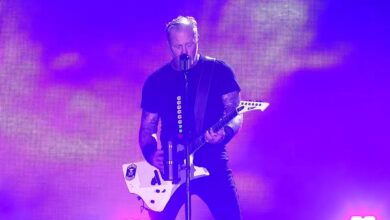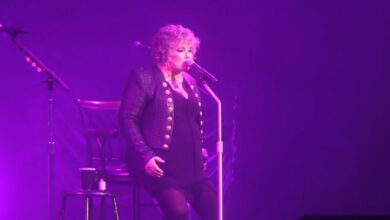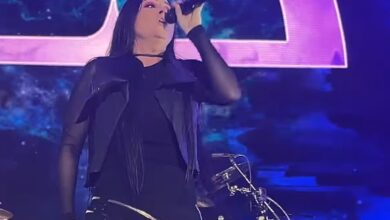Metallica Shook Sydney to Its Core with a Thunderous, Stadium-Shaking “For Whom the Bell Tolls” at Accor Stadium 2025
From early morning on November 15, 2025, Sydney felt less like a laid-back harbour city and more like the staging ground for a metal pilgrimage. Hours before gates opened, fans in Metallica shirts, patched denim and brand-new M72 tour gear were already roaming the streets around Olympic Park. Many had spent the previous day or night at the pop-up merch store in Oxford Street, where die-hards queued up to thirteen hours for limited posters, shirts and even branded skateboards, treating the whole weekend like a once-in-a-lifetime event.
By mid-afternoon, trains pouring into Olympic Park were packed shoulder to shoulder, conversations bouncing between memories of Perth, Adelaide, Melbourne and Brisbane, and predictions about what Sydney’s final set would look like. The knowledge that this might be the band’s last Australian stadium appearance for a long time added a quiet urgency to the air. As crowds flooded the concourses of Accor Stadium, the reality of the scale set in: more than seventy thousand people would share this night, filling every tier and turning the circular M72 stage into the nucleus of a giant human storm.
Once inside, fans had time to take in just how different the M72 production felt compared with a traditional end-stage rock show. The band’s in-the-round setup carved the floor into a ring around the Snake Pit, ringed with eight towering speaker arrays and vast LED screens, ensuring that wherever you stood one of the four members would eventually be right in front of you. Early arrivals staked out rail positions and snapped photos of the looming towers, already imagining how the lighting and pyro would transform everything once darkness fell.
Suicidal Tendencies were first to test the system, blasting across the stadium with punk-thrash chaos that had the early floor moving in messy, joyful circles. Mike Muir paced the stage like a fighter before a title match, and by the end of their slot more than a few people were already sweating through their shirts. Evanescence shifted the energy from feral to cinematic, Amy Lee’s voice soaring over the in-the-round stage while the screens flooded with moody imagery. Their mix of old favourites and newer material gave the evening a sense of drama, like the opening acts of a long carefully built story.
As twilight sank into full darkness the sound of AC/DC’s It’s a Long Way to the Top blasted through the PA, a direct salute to the band’s Australian hosts and a perfect sing-along to loosen up tens of thousands of voices. The screens flashed through decades of live photos, fan shots and tour imagery, weaving a visual history lesson for anyone who had grown up with these songs as the soundtrack to their lives. Then came the familiar swell of The Ecstasy of Gold, sweeping across the stadium like a tide, and every conversation abruptly died down. People raised phones, others simply closed their eyes and soaked in the moment they had waited more than a decade for.
Metallica hit the stage with Creeping Death, detonating the show in a burst of white light and pounding double-time thrash. The first huge roars rose from the floor as the crowd shouted Die by my hand in unison, rail riders yelling every lyric directly into James Hetfield’s face while those in the upper tiers saw the entire circular stage pulsing like a living organism. The opening track felt like both a statement and a warning: this would not be a polite, half-energy reunion, but a full-throttle assault from a band still intent on proving why they have dominated arenas and stadiums for more than forty years.
Then, without much of a pause, everything tightened into that unmistakable war-march groove that signals For Whom the Bell Tolls. Robert Trujillo’s bass rang out with that cold, bell-like tone, echoing through the stadium while Lars Ulrich dropped in with a heavy, stomping beat that made the concrete itself feel like it was breathing. Blue and steel-grey lighting washed across the stage, giving the whole scene a stark, almost battlefield-like mood as James stalked forward, guitar hanging low, eyes locked on the mass of fans gathered around him. The atmosphere shifted from frantic to ominous in a single riff.
When the main riff finally hit, thousands of heads snapped into motion, the entire floor moving as one slow, relentless wave rather than the frantic jumping of a faster song. For Whom the Bell Tolls has always lived in that sweet spot between groove and menace, and in a stadium this size it felt gigantic, every note magnified by the circular speaker towers. You could see people banging fists on the rail in time with each chord, eyes shut, mouthing the lyrics about frozen souls and war-torn hills as if repeating a prayer they had known since adolescence.
In the 4K fan clips that would appear online within hours, the camera’s perspective tells its own story. From the lower bowl you see the entire ring of the stage glowing in cold light, the band spaced out like sentries at different points of the circle. As James launches into the first verse, the audio is almost swallowed by the crowd, tens of thousands of voices adding grain and grit to every line. During the famous instrumental break, phones lift like a galaxy of small stars, their tiny white dots flickering against the deep blue wash bathing the stadium.
Down on the floor, the effect was even more intense. Instead of wild moshing, many fans fell into that classic Bell Tolls stance: feet planted, knees bent, head rolling with every drum hit, one arm stabbing upward on the snare. Older metalheads in faded Ride the Lightning shirts locked in beside teenagers discovering the song live for the first time, united in the same unhurried, heavy sway. You could feel the song’s history in the way people responded, not as a novelty or a surprise, but as a ritual that had been performed in clubs, arenas and festivals for decades and still carried undimmed power.
Part of what made this performance so striking was how clearly it cut through the scale of the M72 production. With so much technology surrounding the band, it would be easy for a mid-tempo 1984 track to get swallowed up, yet For Whom the Bell Tolls came across as lean, muscular and shockingly direct. Kirk Hammett’s leads climbed over the central riff with a sharp, almost vocal phrasing, while James’s guitar tone stayed dry and brutal, more like an artillery barrage than a polished stadium rock sound.
Thematically, the song hit harder than ever in this setting. For Whom the Bell Tolls is not just a war song; it is an examination of futility, of young lives spent on hills that no one will remember. As the lyrics rolled out over a crowd that spanned multiple generations, the contrast was almost eerie: tens of thousands of people celebrating, singing, cheering, while the words spoke of death, frozen eyes and senseless sacrifice. That tension between the joy of the moment and the darkness of the subject gave the performance a strange, magnetic weight.
You could sense that many fans were aware of this history. Some had followed Metallica since their first Australian runs in the late eighties and early nineties, others had discovered the band through streaming playlists in the last few years, but in this moment everyone met in the same shared space. Parents put arms around their kids’ shoulders, friends who had flown in from other states locked eyes and laughed between lines, and the sound of thousands chanting the iconic bass-driven bridge felt like a living bridge between generations of metal listeners.
As the final hits of For Whom the Bell Tolls rang out, the transition into Fuel shifted the gear from grinding march back into full-speed combustion. Yet many people would later say that Bell Tolls was the point where the show truly locked into place, the moment when the initial blast of excitement from Creeping Death crystallised into something heavier and more meaningful. It felt like the first chapter of a long arc that would carry the stadium through Cyanide, The Unforgiven, the Australian tribute jam and eventually the emotional high points of Nothing Else Matters and Enter Sandman.
Through the rest of the night that second song stayed lodged in the memory as a sort of anchor. When the band thrashed through faster material or lit up the sky with pyro, some fans still talked about the way the stadium felt during Bell Tolls: slower, heavier, almost like being inside a giant engine idling at maximum torque. Even while fireworks erupted during the later set closers, people in the concourses could be heard humming the bass intro, the riff echoing in their heads long after the song itself had finished.
By the time the last notes of Enter Sandman finally faded and the band lined up to thank the Sydney crowd, the significance of the night had settled in. This was more than another stop on a long world tour; it was the culmination of an Australian run that had seen the band reclaim stadiums after a twelve-year absence, playing to hundreds of thousands of fans across five cities. In that context, For Whom the Bell Tolls felt like a mission statement buried early in the set: heavy, uncompromising, rooted in their past yet still utterly alive in the present.
In the days that followed social media feeds and fan forums filled with clips, photos and breathless accounts of the Sydney show. Some posts focused on the pyrotechnics of Fuel, others on the emotional sweep of Nothing Else Matters or the cathartic chaos of Master of Puppets and One. Yet again and again a particular run of 4K videos resurfaced, each labelled with the same description: Metallica – For Whom the Bell Tolls [Live 4K] (Sydney, Australia – November 15, 2025). Within each shaky frame you could see what statistics and setlists could never fully capture: a stadium of more than seventy thousand people moving as one to the sound of a song that has refused to age.





